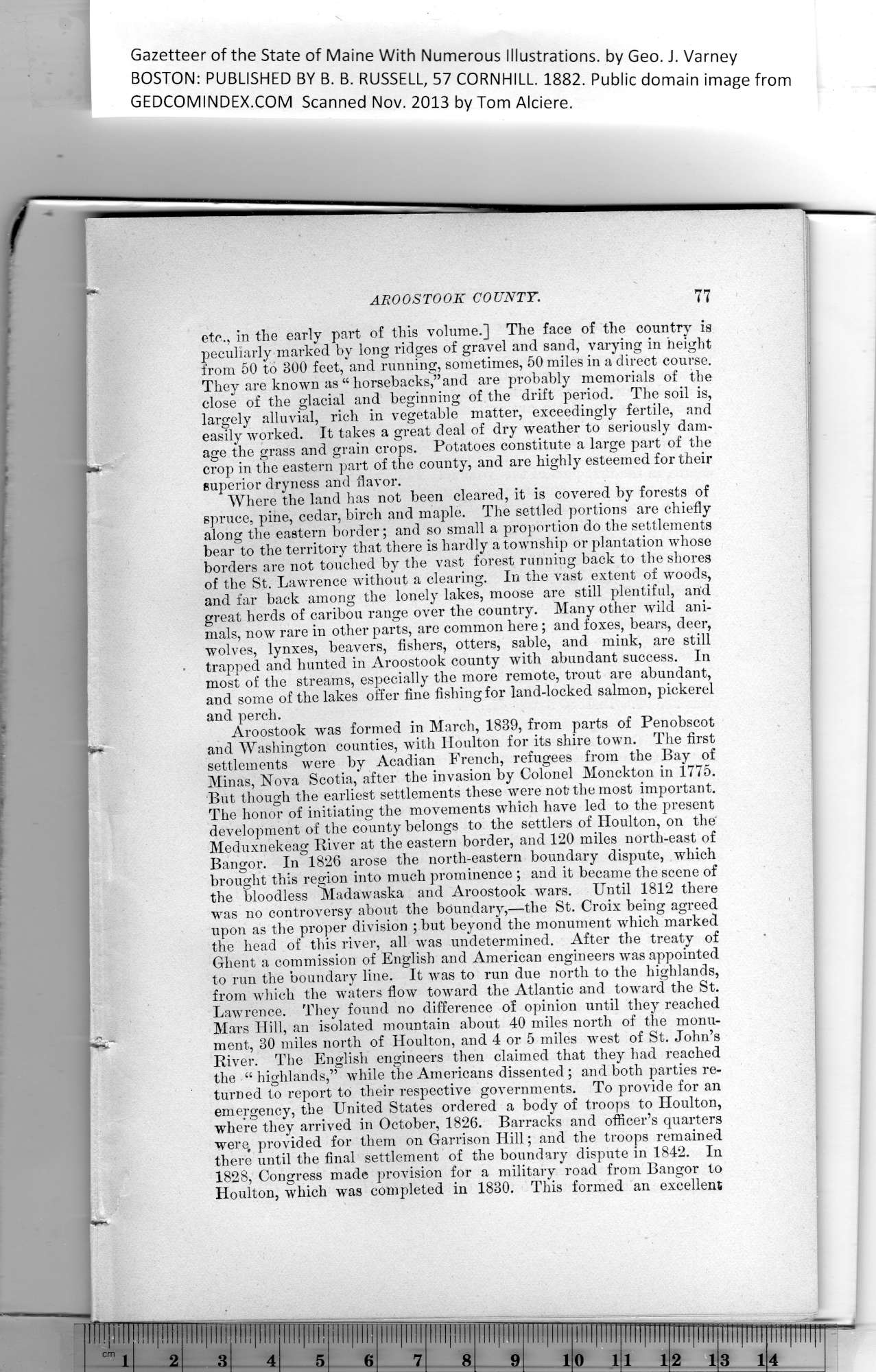|
Gazetteer of the State of Maine With Numerous Illustrations, by Geo. J. Varney
BOSTON: PUBLISHED BY B. B. RUSSELL, 57 CORNHILL. 1882. Public domain image from
etc., in the early part of this volume.] The face of the country is
peculiarly marked by long ridges of gravel and sand, varying in height
from 50 to 300 feet, and running, sometimes, 50 miles in a direct course.
They are known as “horsebacks,’’and are probably memorials of the
close of the glacial and beginning of the drift period. The soil is,
largely alluvial, rich in vegetable matter, exceedingly fertile, and
easily worked. It takes a great deal of dry weather to seriously dam-
age the grass and grain crops. Potatoes constitute a large part of the
crop in the eastern part of the county, and are highly esteemed for their
superior dryness and flavor.
Where the land has not been cleared, it is covered by forests of
spruce, pine, cedar, birch and maple. The settled portions are chiefly
along the eastern border; and so small a proportion do the settlements
bear to the territory that there is hardly a township or plantation whose
borders are not touched by the vast forest running back to the shores
of the St. Lawrence without a clearing. In the vast extent of woods,
and far back among the lonely lakes, moose are still plentiful, and
great herds of caribou range over the country. Many other wild ani-
mals, now rare in other parts, are common here; and foxes, bears, deer,
wolves, lynxes, beavers, fishers, otters, sable, and mink, are still
trapped and hunted in Aroostook county with abundant success. In
most of the streams, especially the more remote, trout are abundant,
and some of the lakes offer fine fishing for land-locked salmon, pickerel
and perch.
Aroostook was formed in March, 1839, from parts of Penobscot
and Washington counties, with Houlton for its shire town. The first
settlements were by Acadian French, refugees from the Bay of
Minas, Nova Scotia, after the invasion by Colonel Monckton in 1775.
But though the earliest settlements these were not- the most important.
The honor of initiating the movements which have led to the present
development of the county belongs to the settlers of Houlton, on the
Meduxnekeag River at the eastern border, and 120 miles north-east of
Bangor. In 1826 arose the north-eastern boundary dispute, which
brought this region into much prominence ; and it became the scene of
the bloodless Madawaska and Aroostook wars. Until 1812 there
was no controversy about the boundary,—the St. Croix being agreed
upon as the proper division ; but beyond the monument which marked
the head of this river, all was undetermined. After the treaty of
Ghent a commission of English and American engineers was appointed
to run the boundary line. It was to run due north to the highlands,
from which the waters flow toward the Atlantic and toward the St.
Lawrence. They found no difference of opinion until they reached
Mars Hill, an isolated mountain about 40 miles north of the monu-
ment, 30 miles north of Houlton, and 4 or 5 miles west of St. John’s
River. The English engineers then claimed that they had reached
tbe “ highlands,” while the Americans dissented; and both parties re-
turned to report to their respective governments. To provide for an
emergency, the United States ordered a body of troops to Houlton,
where they arrived in October, 1826. Barracks and officer’s quarters
were, provided for them on Garrison Hill; and the troops remained
there until the final settlement of the boundary dispute in 1842. In
1828, Congress made provision for a military road from Bangor to
Houlton, which was completed in 1830. This formed an excellent
PREVIOUS PAGE ... NEXT PAGE
This page was written in HTML using a program written in Python 3.2
|
